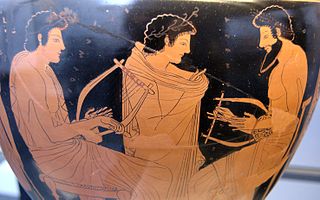
In music, harmony considers the process by which the composition of individual sounds, or superpositions of sounds, is analysed by hearing. Usually, this means simultaneously occurring frequencies, pitches, or chords.
In music theory, the key of a piece is the group of pitches, or scale, that forms the basis of a music composition in classical, Western art, and Western pop music.

In music, timbre is the perceived sound quality of a musical note, sound or tone. Timbre distinguishes different types of sound production, such as choir voices and musical instruments, such as string instruments, wind instruments, and percussion instruments. It also enables listeners to distinguish different instruments in the same category.
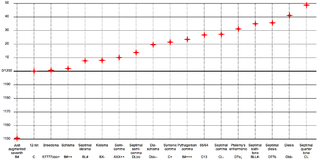
In modern musical notation and tuning, an enharmonic equivalent is a note, interval, or key signature that is equivalent to some other note, interval, or key signature but "spelled", or named differently. Thus, the enharmonic spelling of a written note, interval, or chord is an alternative way to write that note, interval, or chord. For example, in twelve-tone equal temperament, the notes C♯ and D♭ are enharmonic notes. Namely, they are the same key on a keyboard, and thus they are identical in pitch, although they have different names and different roles in harmony and chord progressions. Arbitrary amounts of accidentals can produce further enharmonic equivalents, such as B, although these are much rarer and have less practical use.
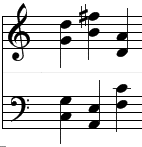
In music theory, a perfect fifth is the musical interval corresponding to a pair of pitches with a frequency ratio of 3:2, or very nearly so.
In guitar music, especially electric guitar, a power chord Play (help·info) is a colloquial name for a chord that consists of the root note and the fifth. Power chords are commonly played on amplified guitars, especially on electric guitar with distortion. Power chords are a key element of many styles of rock and especially in heavy metal, and punk rock.
A nonchord tone (NCT), nonharmonic tone, or embellishing tone is a note in a piece of music or song that is not part of the implied or expressed chord set out by the harmonic framework. In contrast, a chord tone is a note that is a part of the functional chord. Nonchord tones are most often discussed in the context of the common practice period of classical music, but they can be used in the analysis of other types of tonal music as well, such as Western popular music.

Resolution in western tonal music theory is the move of a note or chord from dissonance to a consonance.

In music, unison is two or more musical parts sounding the same pitch or at an octave interval, usually at the same time.

In music, letter notation is a system of representing a set of pitches, for example, the notes of a scale, by letters. For the complete Western diatonic scale, for example, these would be the letters A-G, possibly with a trailing symbol to indicate a half-step raise--(a sharp ♯), or a half-step lowering. This is the most common way of specifying a note in speech or in written text in English or German. In some European countries H is used instead of B, and B is used instead of B♭.
In music, the mystic chord or Prometheus chord is a six-note synthetic chord and its associated scale, or pitch collection; which loosely serves as the harmonic and melodic basis for some of the later pieces by Russian composer Alexander Scriabin. Scriabin, however, did not use the chord directly but rather derived material from its transpositions.
In music, a drone is a harmonic or monophonic effect or accompaniment where a note or chord is continuously sounded throughout most or all of a piece. The word drone is also any part of a musical instrument that is used to produce such an effect, as is the archaic term burden such as a "drone [pipe] of a bagpipe", the pedal point in an organ, or the lowest course of a lute. Α burden is also part of a song that is repeated at the end of each stanza, such as the chorus or refrain.

Guitar tunings assign pitches to the open strings of guitars, including acoustic guitars, electric guitars, and classical guitars. Tunings are described by the particular pitches denoted by notes in Western music. By convention, the notes are ordered from lowest-pitched string to highest-pitched.
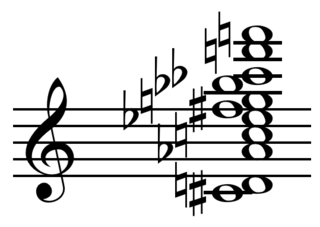
In musical composition, a sound mass is the result of compositional techniques, in which, "the importance of individual pitches," is minimized, "in preference for texture, timbre, and dynamics as primary shapers of gesture and impact," obscuring, "the boundary between sound and noise".

The mathematical operations of multiplication have several applications to music. Other than its application to the frequency ratios of intervals, it has been used in other ways for twelve-tone technique, and musical set theory. Additionally ring modulation is an electrical audio process involving multiplication that has been used for musical effect.
In music, a simultaneity is more than one complete musical texture occurring at the same time, rather than in succession. This first appeared in the music of Charles Ives, and is common in the music of Conlon Nancarrow and others.
In music theory, the word inversion has distinct, but related, meanings when applied to intervals, chords, voices, and melodies. The concept of inversion also plays an important role in musical set theory.

In music theory and harmonic analysis, a synthetic chord is a made-up or non-traditional (synthetic) chord which cannot be analyzed in terms of traditional harmonic structures, such as the triad or seventh chord.
This title is applied to a group of notes, usually a scale-like succession of pitches, with a fixed progression of tones and semitones. This scale can obviously be transposed to any pitch, and depending on its intervallic makeup, will have a fixed number of possible transpositions. Furthermore, the sintetakkord can be used either vertically or horizontally; Roslavets' music is not concerned with the order of the pitches, but rather with the whole 'field' thus created, so that the system is less oriented toward themes and more toward harmonic fields. [See: Josef Matthias Hauer]
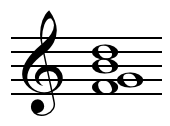
In music, a factor or chord factor is a member or component of a chord. These are named root, third, fifth, sixth, seventh, ninth, eleventh, thirteenth, and so on, for their generic interval above the root.
In harmony, the consonance and dissonance of a chord factor and a nonchord tone are distinguished, respectively.


